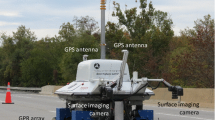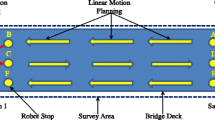Abstract
Infrastructure spending is a major component of railroad annual budgets and therefore must be prioritized to ensure both safety and line capacity at all times. Current inspection priorities for railroads include early detection of structural deterioration, including concrete and timber, caused by the recent increase of car load capacities. Railroad bridge inspectors conduct tap testing to detect the deterioration of concrete and timber acoustically. However, measuring railroad bridge condition in the field is a challenging task and, in general, is solely based on the inspector’s experience. The results of this research describe the development, validation, and testing of a remote tap testing device that can be deployed by an aerial robot. The new tap testing device can remotely impact the surface, record the sounds of those impacts, and post-process the data to perform replacement prioritization. Tapping acoustics were analyzed both in the time and frequency domains. Principal component analysis of the data enabled the clustering of the different sets of data collected from different concrete and timber surfaces. The results quantify for the first time structural tap testing data collected with a tap testing mechanism built for deployment by an aerial robot. The goal of this work is to enable cost-effective, safer and sustainable upgrade prioritization of railroad bridge inventories.





(image by F. Moreu)

(image by F. Moreu)













Similar content being viewed by others
References
American Railway Engineering and Maintenance-of-Way Association (AREMA): AREMA bridge inspection handbook. AREMA Committee 10, Structures Maintenance & Construction Scholarship, Lanham (2008)
American Railway Engineering and Maintenance-of-Way Association (AREMA): Timber structures. Chapter 7, Manual for Railway Engineering, vol. 2. AREMA Committee, Lanham (2014)
Association of American Railroads (AAR): A short history of U.S. freight railroads. AAR, Washington (2014)
Byers, W.G., Otter, D.: Reducing the stress state of railway bridges with research: researchers at TTCI stay on top of railway bridge research to ensure safety, cost effectiveness and maximum life cycle of materials. Railway Track and Structures Report 1953. Simmons-Boardman, Chicago (2006)
Eschmann, C., Kuo, C. M., Kuo, C. H., Boller, C.: Unmanned aircraft systems for remote building inspection and monitoring. In: Proceedings of the 6th European Workshop on Structural Health Monitoring, vol. 36. Dresden, Germany (2012)
Federal Railroad Administration (FRA): Railroad bridge integrity working group upgrade. Railroad Safety Advisory Committee (RSAC), Railroad Bridge Working Group, Presentations (Railroad Bridge Working Group Report: Final Report and Recommendations). FRA, Washington, DC (2008)
Hallermann, N., Morgenthal, G.: Visual inspection strategies for large bridges using unmanned aerial vehicles (UAV). In: 7th International Conference on Bridge Maintenance, Safety and Management, pp. 7–11. IABMAS (2014)
Hallermann, N., Morgenthal, G., Rodehorst, V.: Vision-based deformation monitoring of large scale structures using unmanned aerial systems. In: IABSE Symposium Report, vol. 102(8), pp. 2852–2859. International Association for Bridge and Structural Engineering (2014)
Henderson, M.E., Dion, G.N., Costley, R.D.: Acoustic inspection of concrete bridge decks. In: Nondestructive Evaluation Techniques for Aging Infrastructures and Manufacturing, pp. 219–227. International Society for Optics and Photonics (1999)
JR Technology Limited: Woodpecker Automated Tap Tester—General Information. http://www.jrtech.co.uk/products/ndt-and-inspection/101-woodpecker-automated-tap-tester-general-information (2017). Accessed 01 July 2017
Huston, D., Cui, J., Burns, D., Hurley, D.: Concrete bridge deck condition assessment with automated multisensor techniques. Struct. Infrastruct. Eng. 7(7–8), 613–623 (2011)
Moreu, F., LaFave, J.M.: Current research topics: railroad bridges and structural engineering. In: Report No. NSEL-032, University of Illinois at Urbana, Champaign, Urbana. http://hdl.handle.net/2142/34749 (2012)
Moreu, F., et al.: Reference-free displacements for condition assessment of timber railroad bridges. J. Bridge Eng. 21(2), 04015052 (2015)
Moreu, F., Spencer Jr., B.F., Foutch, D.A., Scola, S.: Consequence-based management of railroad bridge networks. Struct. Infrastruct. Eng. 13(2), 273–286 (2017)
Morgenthal, G., Hallermann, N.: Quality assessment of unmanned aerial vehicle (UAV) based visual inspection of structures. Adv. Struct. Eng. 17(3), 289–302 (2014)
Murphy, R.R., Steimle, E., Hall, M., Lindemuth, M., Trejo, D., Hurlebaus, S., Slocum, D.: Robot-assisted bridge inspection after Hurricane Ike. In: 2009 IEEE International Workshop on Safety, Security and Rescue Robotics (SSRR 2009), pp. 1–5. IEEE, New York (2009)
Otero, L. D., Gagliardo, N., Dalli, D., Huang, W. H., Cosentino, P.: Proof of concept for using unmanned aerial vehicles for high mast pole and bridge inspections (No. BDV28 TWO 977–02). Florida Institute of Technology, Department of Engineering Systems, Melbourne, Florida (2015)
Owens, A., Isola, P., McDermott, J., Torralba, A., Adelson, E.H., Freeman, W.T.: Visually Indicated Sounds. arXiv preprint: arXiv:1512.08512 (2015)
Pearson, K.: On lines and planes of closest fit to systems of points in space. Philos. Mag. 2(11), 559–572 (1901). https://doi.org/10.1080/14786440109462720
Reagan, D., Sabato, A., Niezrecki, C., Yu, T., Wilson, R.: An autonomous unmanned aerial vehicle sensing system for structural health monitoring of bridges. In: SPIE Smart Structures and Materials + Nondestructive Evaluation and Health Monitoring, pp. 980414–980414. International Society for Optics and Photonics (2016)
Richardson, M.: Principal Component Analysis. http://people.maths.ox.ac.uk/richardsonm/SignalProcPCA.pdf. Accessed 3 May 2013 (Aleš Hladnik Dr., Ass. Prof., Chair of Information and Graphic Arts Technology, Faculty of Natural Sciences and Engineering, University of Ljubljana, Slovenia. Mail: ales.hladnik@ntf.uni-lj.si) (2009)
Tarighat, A., Miyamoto, A.: Fuzzy concrete bridge deck condition rating method for practical bridge management system. Expert Syst. Appl. 36(10), 12077–12085 (2009)
Tascam Teac Professional: http://tascam.com/product/dr-44wl/ (downloaded July 14) (2016)
Uppal, A.S., Rizkalla, S.H.: Response of timber bridges under train loading. In: Transportation Research Record 1177. Transportation Research Board, Washington, DC, pp. 103–112 (1988)
Wipf, T.J., Ritter, M.A., Wood, D.L.: Evaluation and field load testing of timber railroad bridge. In: Proceedings of the 5th International Bridge Engineering Conference. National Academy Press, Washington, DC, pp. 323–333 (2000)
Yang, Y., Cattaneo, A., Mascareñas, D.: Potential structural health monitoring tools to mitigate corruption in the construction industry associated with rapid urbanization. In: Third Annual International Conference for Sustainable Development Practice. Implementing the SDGs: Getting Started. Columbia University, New York, USA, September 23 and 24 (2015)
Acknowledgements
This research was performed at the Los Alamos National Laboratory Engineering Institute. Support from the following sources is gratefully acknowledged: The University of New Mexico (UNM) structures laboratory of the Civil Engineering Department; The New Mexico Consortium (NMC), who provided financial support for this research; and the Canadian National Railway (CN), who provided inputs for the feasibility of this research for railroad bridge replacement prioritization in the United States.
Author information
Authors and Affiliations
Corresponding author
Rights and permissions
About this article
Cite this article
Moreu, F., Ayorinde, E., Mason, J. et al. Remote railroad bridge structural tap testing using aerial robots. Int J Intell Robot Appl 2, 67–80 (2018). https://doi.org/10.1007/s41315-017-0041-7
Received:
Accepted:
Published:
Issue Date:
DOI: https://doi.org/10.1007/s41315-017-0041-7




